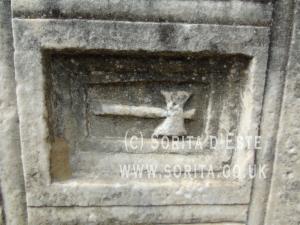Revered throughout history for its enigmatic nature, the Labrys is an emblem transcending time, cultures, and beliefs. Its presence has been recorded in various civilizations across the globe, leaving behind a trail of intrigue and fascination. I was inspired to pull my old ring out of my jewelry box. It is a little too big, but it still holds a fantastic luster, shine, and a special place in my heart.
Heralded as a symbol of power, protection, and spiritual enlightenment, the Labrys have permeated ancient societies, ranging from the Minoans in Crete to the Amazon warriors of myth and legend. It is also associated with the God Zeus, who used it to call lightning from the heavens. You can find more on Zeus' Labrys here.
Beyond its physical representation, the Labrys embodies a multifaceted concept, embodying feminine energy and divine strength. Its curved blades, intersecting paths, and labyrinthine complexity beckon us to reflect on the intricate tapestry of life itself.
The Labrys, also known as the Labrys or Double Axe, holds significant historical and cultural importance in both Minoan civilization and Amazonian mythology. Let's delve deeper into each of these contexts and explore their connections.
The Minoans, an ancient Bronze Age civilization that thrived on the island of Crete (circa 2700-1450 BCE), were known for their advanced culture, vibrant art, and complex religious practices. The Labrys emerged as a prominent motif among their symbols, often associated with their powerful female deities.
In Minoan art, the Labrys were depicted as a double-headed axe, resembling a symmetrically arranged butterfly or an inverted V-shape. It symbolized strength and femininity, representing the divine feminine power permeating Minoan society. The Labrys have been found in various contexts, from intricate frescoes and pottery designs to statuettes and architectural reliefs.
 |
| Minoan Snake Goddess Photo - Renee Sosanna Olson |
The Labrys held a solid connection to Minoan religion and rituals, often associated with goddesses such as the well-known Snake Goddess. It represented the authority and influence of these female deities, signifying their roles as protectors, guardians, and sources of life-giving power.
In Greek mythology, the Amazons were a legendary tribe of warrior women said to dwell in regions such as Scythia, Anatolia, and the Black Sea. According to various accounts, they were renowned for their exceptional combat skills and society's matriarchal structure.
The Labrys was often linked to the Amazons as a symbol of their power and prowess in battle. Ancient Greek texts and artwork depicted the Amazons wielding the Labrys in battle, emphasizing their skill, bravery, and strength. Some accounts even describe the Labrys as a weapon unique to the Amazons, granting them mythical abilities.
 |
| Minoan Ceremonial Axe http://blog.cnbeyer.com/history/the-minoan-labrys-or-cutting-through-a-historical-mystery/ |
The connection between the Minoans and the Amazons lies in their shared symbolism of female empowerment, strength, and the divine feminine. While the exact nature of their relationship remains speculative, the parallels in depicting the Labrys reflect the enduring archetype of the powerful, independent woman in various cultures. Coming from a home where women were oppressed and made to feel less than men, this connection to Amazon's fierce female warriors inspired me to think things could change.
In the Minoan context, it represents the divine feminine power and is associated with the goddesses of their pantheon. In Amazonian mythology, the Labrys symbolize the strength and prowess of the legendary warrior women. Despite geographical and temporal distances, the symbolism of the Labrys connects these cultures through their shared recognition of women's transformative power and influence. For a deeper dive into the Minoas and the Labrys, I recommend checking out Laura Perry's book Labrys & Horn. See more on this book on her website.
The connection between the Labrys and the carvings found at Lagina in Turkey, specifically at the Temple of Hecate, adds another intriguing layer to the symbolism and significance of this ancient emblem.
 |
| Carving at the Temple of Hecate in Lagina Photo Credit - Sorita d'Este |
The Temple of Hecate, located in Lagina (modern-day Turkey), was a sanctuary dedicated to the goddess Hecate, an influential figure associated with magic, crossroads, and the liminal realms in Greek mythology. Hecate, often depicted as a triple-bodied goddess, held a complex role as a guardian, guide, and mistress of sorcery.
Within the Temple of Hecate context, carvings, and reliefs featuring the Labrys have been discovered, further linking this symbol to the worship and reverence of the goddess. These carvings typically depict the Labrys in combination with other symbols and motifs associated with Hecate, such as serpents, torches, crescent moons, and keys.
Including the Labrys in the iconography of the Temple of Hecate suggests its role as a symbol of power, protection, and magical authority, aligning with the attributes attributed to Hecate herself. It signifies the connection between Hecate and the divine feminine energy embodied by the Labrys, emphasizing the goddess's role as a protector and guide in the spiritual realm.
Moreover, the Temple of Hecate at Lagina served as a center for mystical practices, divination, and rituals associated with the goddess. The presence of the Labrys in the temple's carvings may indicate its use as a ceremonial object or tool within the religious practices performed there, further emphasizing its association with the realms of magic, transformation, and spiritual enlightenment.
The carvings found at Lagina in the Temple of Hecate establish a link between the Labrys and the worship of the goddess. The presence of the Labrys in conjunction with other symbols associated with Hecate suggests its role in the realm of magic, protection, and spiritual guidance. This connection highlights the profound symbolism and reverence attributed to the Labrys within the context of the Temple of Hecate and the worship of the goddess in ancient times.
The connection between the Labrys and the LGBTQ+ community is a more modern development, primarily stemming from the association of the Labrys with feminism and women's empowerment. And this is how I first saw this symbol. While the historical origins of the Labrys do not specifically link it to LGBTQ+ identities, its adoption as a symbol within the LGBTQ+ community is a testament to the diverse ways in which symbols can be reinterpreted and reclaimed. When I saw it in the case, I knew it was the one for me. I choose it for its appearance of strength, power, and feminine energy.
 |
| The labrys seen in symbols related to the LGBTQI Community |
In the context of LGBTQ+ activism, the Labrys has been embraced as a symbol of lesbian and queer identity, particularly among women. The Labrys is seen as a representation of female strength, resilience, and solidarity. Its double-headed nature has also been interpreted as celebrating same-sex love and partnership.
 |
| Labrys Ring was purchased in Norfolk Va 30 years ago Photo Credit - Rev. Renee Sossanna Olson |
 |
| The Labrys flag was adopted in the 1970s for the Lesbian Community. |
It's important to note that adopting symbols like the Labrys by marginalized communities is a dynamic and evolving process. The meaning and significance of symbols can vary within different cultural, historical, and contemporary contexts. The Labrys, with its historical associations with feminine power and subsequent adoption as a symbol of LGBTQ+ pride and empowerment, represent the intersectionality and diversity within the LGBTQ+ community.
The connection for the labrys was much more personal for me. It was a way to connect with a community I had just discovered while staying safely hidden away from the threats to their being. I was still peeking out of the closet and learning who I was. This symbol helped me transition into my new place without fear and with a sense of power and pride. Before I was introduced to Hecate, she opened the closet door and guided me through a challenging situation, and I had yet to learn her name.
Thank you to my dearest Sorita for inspiring this article with a simple prompt to dig deeper when sharing her photo. You can read more on her trip to the Temple of Hecate in Lagina on her blog here.
 |
| Sorita d'Este and I in New Orleans Photo Credit - Rev. Renee Sosanna Olson |
From its ancient roots intertwined with Minoan civilization and the legendary Amazons, to its presence within the Temple of Hecate, the Labrys has woven a tapestry of symbolism and significance throughout history.
Yet, its story doesn't end there. In the ever-evolving narrative of human expression and identity, the Labrys has found resonance within the LGBTQ+ community. It has become a symbol of strength, solidarity, and the celebration of diverse love and empowerment.
The Labrys stands as a testament to the transformative power of symbols, its ability to transcend time, cultures, and boundaries. It reminds us that symbols possess a dynamic nature, capable of embracing new meanings and connecting with diverse communities.
As we honor the rich tapestry of history and mythology, we also celebrate the spirit of inclusivity and acceptance. The Labrys, once a symbol of ancient goddesses and mythical warriors, now joins the pantheon of symbols that signify pride, resilience, and the beauty of LGBTQ+ identities.
In the interplay of tradition and progress, the Labrys invites us to reflect on the timeless quest for self-discovery, personal empowerment, and the forging of authentic paths. It encourages us to embrace our inner strength, navigate the labyrinthine depths of our identities with courage, and honor the diverse journeys that shape us.
May the Labyrs continue to inspire and empower as a symbol of ancient wisdom and a beacon of LGBTQ+ pride. As we navigate the labyrinth of life, may we forge new paths, celebrate our diversity, and emerge stronger, together.
Ultimately, the Labrys reveals itself as a symbol of unity, transcending time and embracing the beauty of human identity in all its glorious forms.
(cross-posted on the Covenant of Hekate Website)
Be You and Happy Pride










No comments
Post a Comment